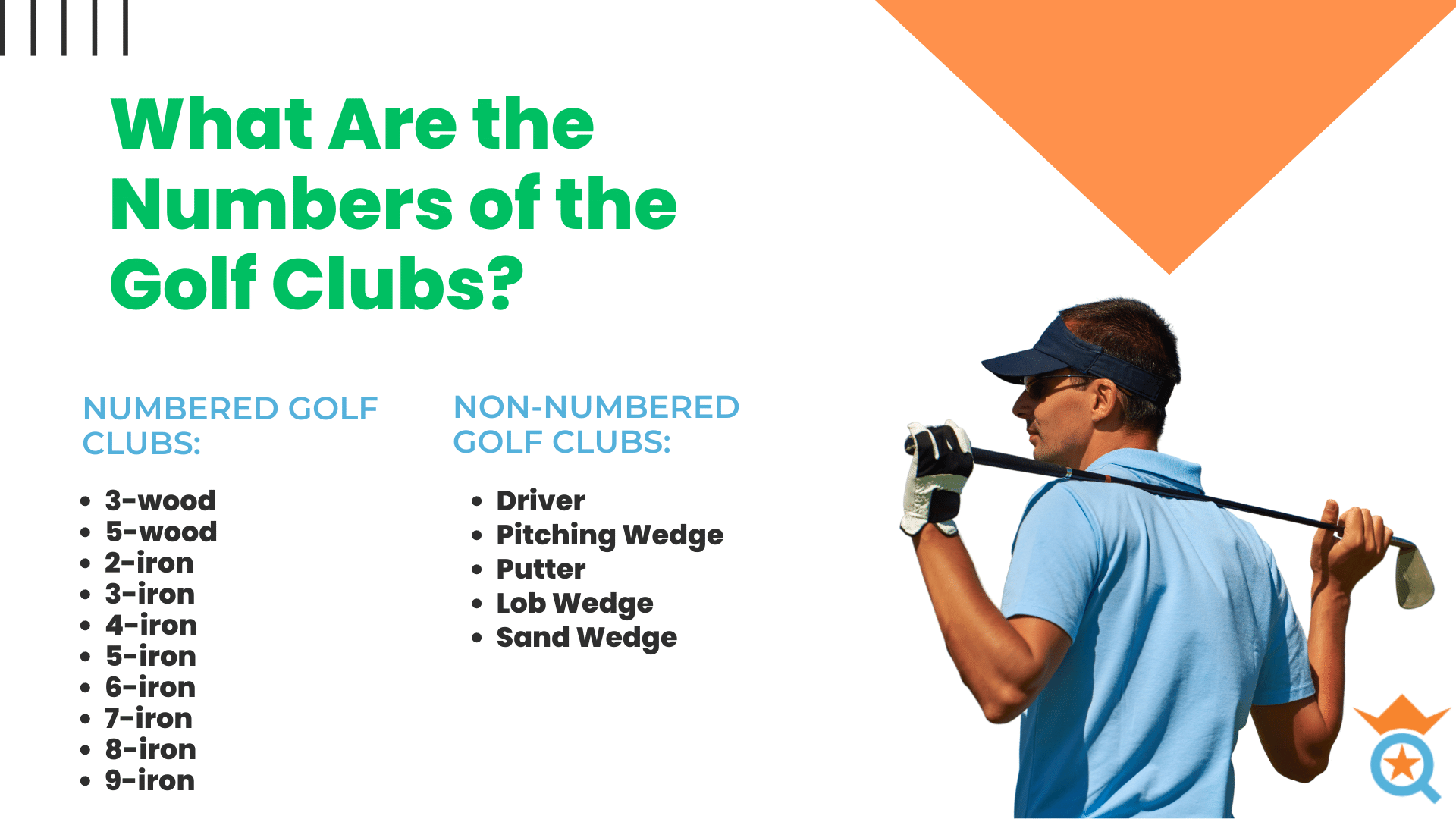Golf is an intricate game of finesse and skill; selecting the club that'll make each shot count can be a daunting task. Here, we've created an all-encompassing guide to help both novice golfers and seasoned pros alike understand which clubs are best suited for various shots around the course.
Whether it's brushing up existing skills or learning from scratch, take advantage now of our comprehensive guide to select exactly what suits you most when out playing 18 holes.

What Are the Numbers of the Golf Clubs?
When it comes to golf clubs, there are two main types: numbered and non-numbered. Numbered clubs range from 2-9 and are identified by their number, while non-numbered clubs have specific names.
Here are the clubs that fall under each category:

Numbered Golf Clubs:
- 3-wood
- 5-wood
- 2-iron
- 3-iron
- 4-iron
- 5-iron
- 6-iron
- 7-iron
- 8-iron
- 9-iron
Non-Numbered Golf Clubs:
- Driver
- Pitching Wedge
- Putter
- Lob Wedge
- Sand Wedge
Each golf club is designed for a specific purpose and can help golfers achieve different shots and distances. Golfers typically carry a combination of clubs to ensure they have the necessary tools for different situations on the course.
What Do a Golf Club's Numbers Mean?
Understanding the numbers on your golf clubs is crucial for selecting the right club for each shot. Golf club numbers correspond to the loft, which is the angle of the club face. The loft determines the height and distance the golf ball will travel when hit.
When it comes to choosing the right golf club for each shot, the lower the golf club number, the less loft, and the more distance the ball will travel at a lower height. Conversely, the higher the golf club number, the more loft, and the higher the ball will travel but for a shorter distance.
For instance, fairway woods typically have higher numbers, such as 3-wood, 5-wood, and 7-wood, which are ideal for long shots on the fairway or off the tee. On the other hand, short irons like the pitching wedge and sand wedge have higher lofts, making them suitable for shorter approach shots and bunker play.
It's essential to choose the right golf club for each shot to ensure optimal performance. When making a tee shot, for example, the club of choice would typically be a driver, which is the lowest lofted club in the bag. For shots off the fairway, players may opt for a fairway wood or iron, depending on the distance and trajectory required.
Knowing the average distance each club can achieve is also vital. By understanding the typical range of each club, players can make informed decisions on which club to use for each shot. It's worth noting that every player's swing is unique, and the distance achieved with each club may vary from one player to another.

How to Choose Which Golf Club Is Right for You
Choosing the right golf club for each shot requires knowledge and practice. Here is a breakdown of how to choose which golf club is right for you:
| Club | What It’s For |
|---|---|
| Driver | Teeing off from the tee box or occasionally hitting from a good lie in the fairway. |
| Hybrid Club | Getting shots of 150+ yards airborne. |
| 2- to 9-Iron | Hitting toward the green, usually from 120–190 yards away – use low-numbered irons for longer shots, and high-numbered irons for shorter shots. |
| Wedges | Hitting short, high shots near the green or from sand bunkers. |
| Putter | Rolling the ball into the hole after it’s on the green (or occasionally from just off the green). |
With practice, you can get an idea of which golf club you should use for a specific shot by knowing how far you can hit with each golf club in your set. The best way to do this is by hitting about 50 balls with each club and eliminating the longest five and shortest five then finding out what remaining average yardage was achieved.
By understanding these basics, using your data, and developing a strategy for each hole, you can make sure your bag has all of the clubs you need and that you know when to use them as well as how to use them correctly for maximum performance on every hole!

What Distinguishes a 3 and 5 Wood From a 3 and 5 Iron?
The main difference between a 3 and 5-wood and a 3 and 5-iron is the type of club they are and their intended use on the golf course. Woods are typically designed for longer shots and have larger heads, while irons are designed for shorter shots and have smaller heads.
The number assigned to each club also indicates the loft angle of the club face. A 3-wood and 3-iron may have the same loft angle, but the 3-wood has a larger head and is designed for longer shots off the tee or fairway. The larger head of the 3-wood allows for more forgiveness on off-center hits and can help get the ball up in the air easier for longer carry distances.
Similarly, a 5-wood is designed for longer shots than a 5-iron. The larger head of the 5-wood also allows for more forgiveness on off-center hits and can help get the ball up in the air easier for longer carry distances. The 5-iron, on the other hand, is designed for shorter approach shots into the green and has a smaller head for better control and precision.
Another factor that distinguishes woods from irons is the material they are made of. Woods are typically made of metal or composite materials, while irons are made of metal. This difference in the material can also affect the feel and performance of the club.
Overall, the choice between a 3 or 5-wood and a 3 or 5-iron comes down to personal preference and the specific shot you are trying to hit. Golfers should consider the distance they need to cover, the terrain and hazards on the course, and their own skill level when choosing which club to use.
What Makes an Iron Club Different from a Wood Club?
The main difference between wood golf clubs and iron golf clubs is the design of their club heads and the purpose for which they are used.
Wood golf clubs
Typically used for long-range shots, especially off the tee. They have large, circular club heads, which are usually made of metal or composite materials. The flat front of the club head is used to strike the ball, and the shape of the head is designed to provide maximum distance and accuracy. Woods are numbered from 1 to 5, with the lower numbers indicating longer clubs that are used for long shots.
Iron golf clubs
On the other hand, are typically used for shorter shots, particularly shots from the fairway or rough. They have smaller, more angled club heads, which are usually made of forged iron. The shape of the head is designed to provide more control and precision than wood clubs, allowing golfers to shape their shots more easily. Irons are numbered from 1 to 9, with the higher numbers indicating shorter clubs that are used for shorter shots.
Wood golf clubs are best suited for long-range shots off the tee, while iron golf clubs are better for shorter shots from the fairway or rough. Most golfers carry a combination of both wood and iron clubs in their bag, along with a putter and possibly some specialty wedges for specific types of shots.
Popularity of the Game
Conclusion
Choosing the right golf clubs for your game can be a daunting task. It is important to consider what type of shot you are attempting, what material the club is made from, and what number it has when deciding which golf club to use. Woods are typically used for long-range shots off the tee, while irons are better for shorter, more controlled shots.
Ultimately, what golf club to use will come down to personal preference and what works best for your skill level. With the right combination of clubs in your bag, you can be sure to have success on the golf course!
FAQs
What golf club is used for tee shots?
The golf club used for tee shots is called the driver. As the name suggests, it is used to hit the ball off the tee, which is the starting point for each hole on the golf course. The driver is the longest club in a golfer's bag and has a larger clubhead, longer shaft, and less loft than other clubs. This design allows the golfer to hit the ball farther and with more speed, making it a popular choice for tee shots. However, because of its length and low loft, the driver can be difficult to control, and some golfers may prefer to use other clubs, such as a 3-wood or hybrid, for tee shots depending on the situation.
What club should you use on a par 3?
When playing a par 3 course, it's essential to have a set makeup that includes a 7 iron, 9 iron, wedge, and putter. These clubs are versatile enough to handle most of the situations that arise on a par 3 course. A par 3 course is an excellent way to practice your golf game and improve your skills, as it provides a great opportunity to work on your short game.
By learning to hit different shots with your irons and wedges, you can develop the ability to control your ball and play golf with more accuracy. If some of the holes are longer than others, then a hybrid club may be a good addition to your set, as it can provide the distance you need without sacrificing accuracy. With this set of clubs, you can enjoy playing golf on a par 3 course and challenge yourself to improve your skills.
What is the easiest golf club to hit?
The easiest golf club to hit is typically the driver, especially those that are 460cc and feature a shallow profile. These drivers have a larger sweet spot and a deep, low center of gravity, which makes them forgiving for golfers who may not hit the ball consistently.
Additionally, perimeter weighting helps to increase the club's stability, resulting in straighter shots on average. For golfers who struggle with distance, a forgiving driver can also help to maximize their average distance off the tee.
However, it's worth noting that while larger drivers are easier to hit, they may not offer the same level of workability as smaller drivers favored by better players. As such, golfers of all levels may need to experiment with different clubs to find the one that suits their swing and playing style.
Should your swing be the same for every club?
For a full golf swing, it doesn't matter which club you're using; the swing remains the same. Yet, the arc at the bottom of a swing and the quantity of divot taken are both affected by the length and size of the club.
In golf, the arc of a club determines how deep of a divot it leaves, with shorter clubs leaving a deeper divot and longer clubs leaving a shallower divot. Hence, golfers should make slight tweaks to the mechanics of the swing to accommodate for the differences in club length and size, while maintaining the same fundamentals.








